artwork by GPT-4o
Applied BMAD - Reclaiming Control in AI Development
Enterprise leaders are pouring investment into AI-assisted development, but many are finding that the promised productivity gains come at a steep price: a loss of governance, traceability, and architectural integrity. Unstructured, prompt-driven AI use is creating “black box” codebases that are difficult to maintain, audit, and scale, introducing significant business risk. To move from ad-hoc experimentation to enterprise-grade AI integration, a new paradigm is required.
We applied BMAD Method (Breakthrough Method for Agile AI-Driven Development) as a strategic framework to ensure that AI-driven development is not only fast but also predictable, compliant, and aligned with long-term business objectives. Integrated with robust version control, this method offers a transformative paradigm for AI engineering, enabling super individual to work with unparalleled precision and clarity.
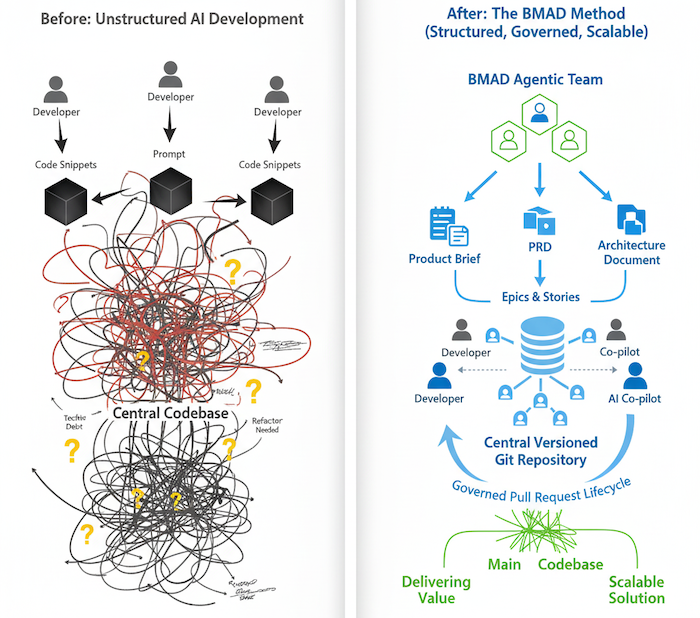 Figure. Visualizing the transformation from fragmented, high-risk AI experimentation to BMAD’s structured, enterprise-ready development framework
Figure. Visualizing the transformation from fragmented, high-risk AI experimentation to BMAD’s structured, enterprise-ready development framework
The Abstraction Trap: Loss of Control
The core problem stems from the inherent tension between abstraction and control in AI-assisted coding. As illustrated in the AI-generated code process, a high-level natural language prompt is transformed through AI models into source code, eventually becoming a running program. While this offers immense speed, it often acts as a black box.
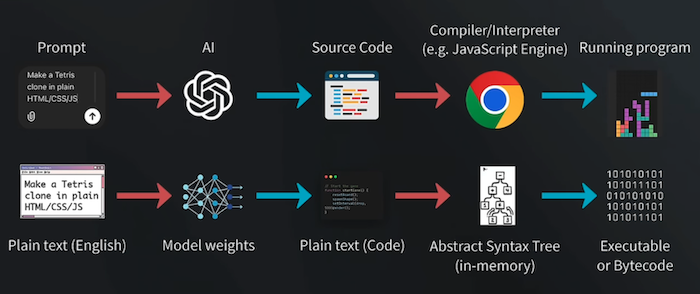 Figure. The typical AI code generation process today, illustrating a linear transformation from a high-level prompt to a running program. This “black box” approach often requires developers to iterate extensively on prompts, restarting the process with each change and hoping the AI interprets and corrects issues effectively (source: Philomatics 2024).
Figure. The typical AI code generation process today, illustrating a linear transformation from a high-level prompt to a running program. This “black box” approach often requires developers to iterate extensively on prompts, restarting the process with each change and hoping the AI interprets and corrects issues effectively (source: Philomatics 2024).
As programming languages and tools increase in their level of abstraction, developers gain immense speed but face a corresponding loss of control. Writing low-level code offers precision and accountability, while high-level code introduces efficiency at the expense of some oversight. With natural language prompts as our programming language to AI-generated programs, this trade-off deepens.
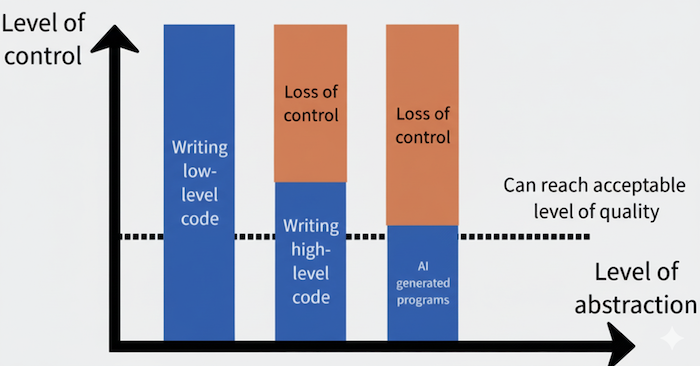 Figure. Higher abstraction accelerates development but sacrifices control, with AI tools amplifying speed at the cost of precision and accountability (source: Philomatics 2024).
Figure. Higher abstraction accelerates development but sacrifices control, with AI tools amplifying speed at the cost of precision and accountability (source: Philomatics 2024).
The philosophical underpinning, as Harrison Ainsworth’s “Tractatus Computo Philosophicus” eloquently states, is that “Software is a logical construction,” and “its correctness must ultimately be left to human judgement.” Current AI tools, while powerful, lead to a noticeable “Loss of control” as the level of abstraction increases. This gap leaves developers and consultants struggling to ensure precision, track intent, and confidently modify AI-generated solutions. When an AI produces code that isn’t quite right, the iterative process of refining prompts becomes a guessing game, devoid of structured collaboration or versioned accountability. This unstructured AI assistance, beneficial for individual tasks, falls short in multi-person, multi-stage team environments, leading to disparate outputs and a lack of collective understanding.
From Chaos to Clarity: The BMAD Method
The BMAD Method provides the crucial framework to re-establish control. At its heart, BMAD leverages specialized AI agents, each embodying a specific role within the software development lifecycle: Analyst, Product Manager, Architect, Scrum Master, Product Owner, Developer, and QA.
Unlike traditional AI tools that merely assist an individual, BMAD agents collaboratively generate and refine critical project artifacts, ensuring an unprecedented level of precision from the project’s inception.
The true transformation, however, lies in overlaying this agentic process with robust Git-based versioning. Every artifact, from the Product Requirements Document (PRD) to the architecture and granular stories, is treated as a versioned asset. This crucial step ensures:
-
Traceability and Accountability: Every change, whether from a human or an AI agent, is thoroughly tracked. This eliminates the black-box effect, providing a clear audit trail that is crucial for regulated industries and internal governance standards.
-
Collaborative Review and Refinement: Stories undergo rigorous pull request (PR) reviews where humans and AI agents inspect and comment on AI-generated content. This structured feedback loop prevents the accumulation of technical debt and reduces post-release bugs, directly lowering maintenance costs.
-
A Single Source of Truth: With all planning and implementation artifacts versioned and centralized, the entire team operates from a consistent blueprint. This prevents costly context loss between teams and reduces the rework common in projects with siloed information.
-
Enhanced Productivity and Quality: By automating the creation of high-fidelity project artifacts, BMAD significantly accelerates development cycles. This allows teams to deliver value to market faster, improving the overall return on investment (ROI) for software projects.
Designed for the Enterprise: Governance, Security, and Scalability
Unlike individual productivity tools, the BMAD Method is designed for enterprise scale.
-
Governance and Compliance: BMAD inherently builds a governance layer into the development lifecycle. Every requirement, architectural decision, and code change is versioned and auditable, creating what is effectively a “continuous compliance ledger.” This machine-readable history simplifies compliance with standards like SOC 2 or HIPAA by providing unparalleled transparency for stakeholders and transforming internal audits from a painful, manual process into an efficient, automated review.
-
Security by Design: By defining security requirements and architectural patterns early in the Al-driven planning phase, BMAD ensures security is not an afterthought. Al agents are tasked with incorporating security best practices directly into generated stories, and automated security scans in the PR pipeline validate these controls, with the evidence recorded in the compliance ledger.
-
Scalability for Distributed Teams: By creating a single, version-controlled source of truth, BMAD enables large, globally distributed teams, and their AI collaborators, to work in parallel on complex systems without sacrificing alignment or quality.
Case Study: Building with BMAD Method
To prove the efficacy of this method, we applied it to a complex, high-stakes challenge: modernizing a mission-critical, yet poorly documented legacy software system. The target was a core transaction-processing module written in an archaic language, representing a significant operational risk and a multi-million dollar problem for the organization. The goal was to build our modernization platform strategy, an enterprise-grade solution designed to analyze, untangle, and modernize such complex codebases where unstructured AI development would introduce unacceptable risk.
The platform’s ability to ingest, visualize, and analyze diverse codebases is a direct consequence of a development process that prioritized precision from the outset. The true test was not simply handling multiple programming languages, but untangling the specific, high-risk legacy module. This challenge was defined by our Product Manager agent, which ingested ambiguous requirements from the obscure legacy code. This input was then translated by the Architect agent into a scalable, modern microservice architecture designed to replace the old module. This structured, Al-assisted planning phase was critical to managing the project’s inherent complexity from day one. The victory was not just in creating new code, but in being able to provably trace this new microservice all the way back to the specific, previously opaque business logic in the old system.
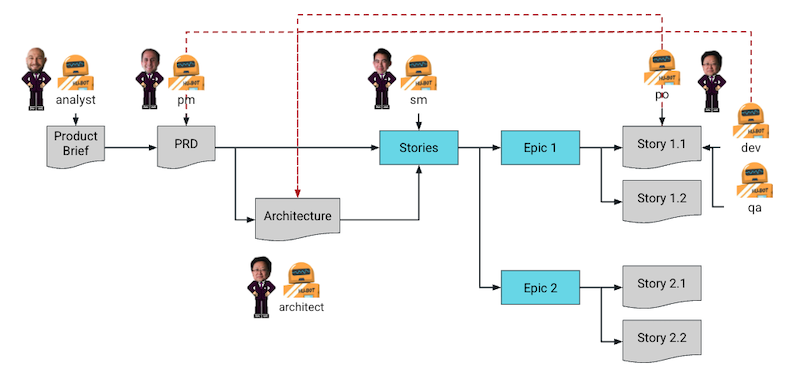 Figure. BMAD development process, a collaboration of human and AI in a consistent and trackable method.
Figure. BMAD development process, a collaboration of human and AI in a consistent and trackable method.
The following sections outline this disciplined, three-step process.
Step 1: Laying the Foundation: From Product Brief to Versioned Architecture
The process begins with a deligent, AI-assisted planning phase. AI agents, guided by human stakeholders, generate the initial Product Brief, a detailed Product Requirements Document (PRD), and a comprehensive Full-stack Architecture Document. These artifacts, detailing everything from multi-tenancy and vector database integration to API specifications, are immediately committed to a Git repository, creating an auditable blueprint for all subsequent work.
Step 2: Parallel Development: Empowering Teams with AI-Assisted Coding in Git
With the foundation set, a Scrum Master agent breaks down the work into manageable Epics and Stories. Each story is developed on a dedicated Git branch, allowing multiple teams to work in parallel. Within their branches, human developers use AI coding assistants, but with a critical difference: the AI’s output is informed by the highly contextualized, version-controlled story files. Crucially, this is augmented by a versioned ”Control Manifest”, a formal document created and committed to Git by the human developer before generation begins. This manifest allows the developer to set explicit, auditable guardrails, such as mandating specific libraries, defining performance constraints, or designating “code exclusion zones” the AI is forbidden to modify.
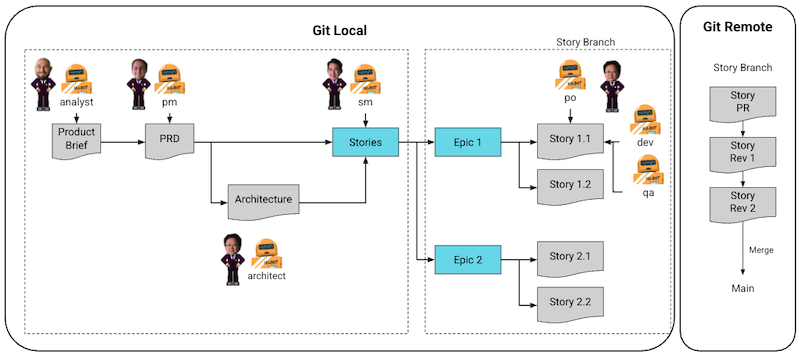 Figure. By adding version control, the development can share the artifacts in a organized manner, matching with our understanding of agile software development process. But this time, with AI.
Figure. By adding version control, the development can share the artifacts in a organized manner, matching with our understanding of agile software development process. But this time, with AI.
The human developer remains firmly in control, not by passively reviewing output, but by actively steering the AI with versioned constraints. This transforms the human’s role into that of an active controller, ensuring every AI-generated line of code adheres to the versioned architecture and safety requirements. The AI acts as an intelligent co-pilot, executing within a clearly defined and auditable flight plan set by its human counterpart.
Step 3: Continuous Alignment: Iterative Refinement Through Agent-Led Reviews
When a developer completes a story, they create a Pull Request, which triggers an automated CI/CD pipeline for testing, quality scans, and security analysis. The PR is then reviewed by peers and specialized AI agents (e.g., a QA Agent, a Product Owner Agent) that check for adherence to the versioned PRD and architecture. This multi-layered review process enables rapid feedback and acts as a continuous quality gate, preventing technical debt and ensuring that only thoroughly vetted code is merged. This disciplined, AI-augmented process allowed us to deliver a sophisticated, multi-tenant SaaS platform with a level of precision and speed unattainable with unstructured AI development methods.
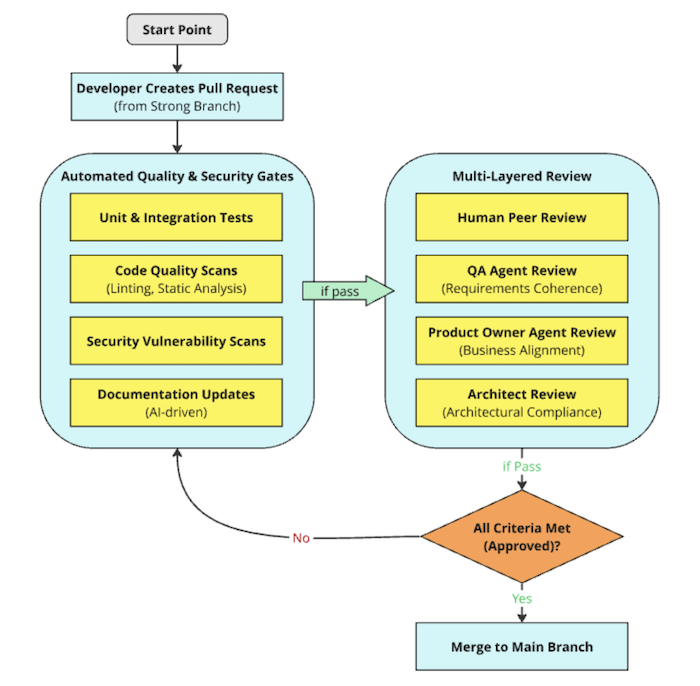 Figure. BMAD’s multi-layered PR lifecycle integrates automated quality gates and agent-driven reviews, ensuring rigorous governance, compliance, and controlled delivery.
Figure. BMAD’s multi-layered PR lifecycle integrates automated quality gates and agent-driven reviews, ensuring rigorous governance, compliance, and controlled delivery.
The Future of Collaborative AI Development
For software consultants and enterprise leaders, the path forward in the Al era is clear: the undisciplined use of Al tools is a liability, not a strategy. The integration of the BMAD Method with version control offers a blueprint for transforming Al from a volatile assistant into a reliable, enterprise-ready partner. This framework moves development beyond individual augmentation to a truly collaborative, auditable, and scalable workflow that serves as an ”audit defense blueprint.” When regulators or internal auditors ask for evidence of compliance, the versioned history provides an immediate, irrefutable answer, directly mitigating financial and operational risk.
This approach is more than just a new process; it is a fundamental shift in how we build and manage software. By embracing this level of control and clarity, we are not just building software faster; we are building the future of software engineering itself, positioning us at the forefront of this transformation.
References
- BMad Method - Foundations in Agentic Agile Driven Development, known as the Breakthrough Method of Agile AI-Driven Development
- BMad Code, The Official BMad-Method Masterclass (The Complete IDE Workflow), video, 2 Aug 2025.
- As the creator of the BMad-Method, I’m finally presenting the official, definitive masterclass on the entire system. Many channels have given a high level quick run through of the basic concepts, but there is so much more and in this video I will cover every agent, all of their amazing powers, and why this is still the best system available - but now made even better as it can fully be run from the IDE with the amazing power of Claude Code.
- Vishal Mysore, What is BMAD-METHOD™? A Simple Guide to the Future of AI-Driven Development, Medium, 9 Sep 2025.
- BMAD framework offers a surprisingly simple, yet highly innovative solution to agentic development. This article provides a deep dive into my experiments with BMAD method, explaining how it gave me a structured, persona-based workflow for building intelligent AI agents. I will walk through the core concepts and show you how to set up your first BMAD project.
-
Philomatics, AI Won’t Fix the Fundamental Flaw of Programming, video, 25 Nov 2024.
- Harrison Ainsworth, Tractatus Computo-Philosophicus, HXA articles, 14 Feb 2011.
- This article offers a philosophical perspective on the nature of software development, intentionally mimicking the style of Wittgenstein’s Tractatus. It begins by asserting that software is a logical construction that functions like a proposition, realizing an intention rather than describing the world. It suggests that software engineering primarily aims for the clarification of development, building tools that make the process of construction and intention clearer.